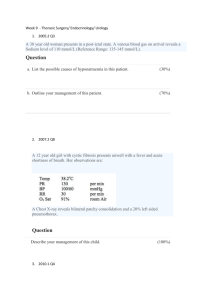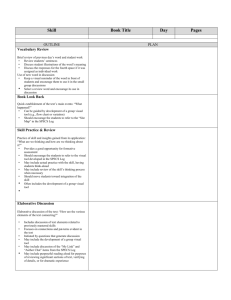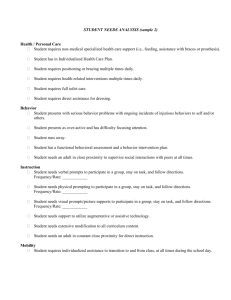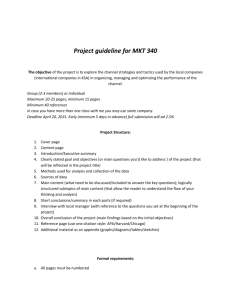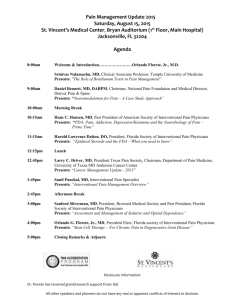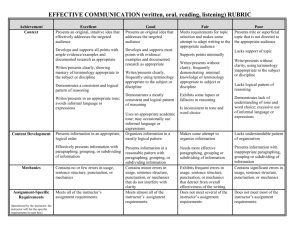Paediatric Revision Course 2015 Dr Lydia Burland Mock Slide
advertisement
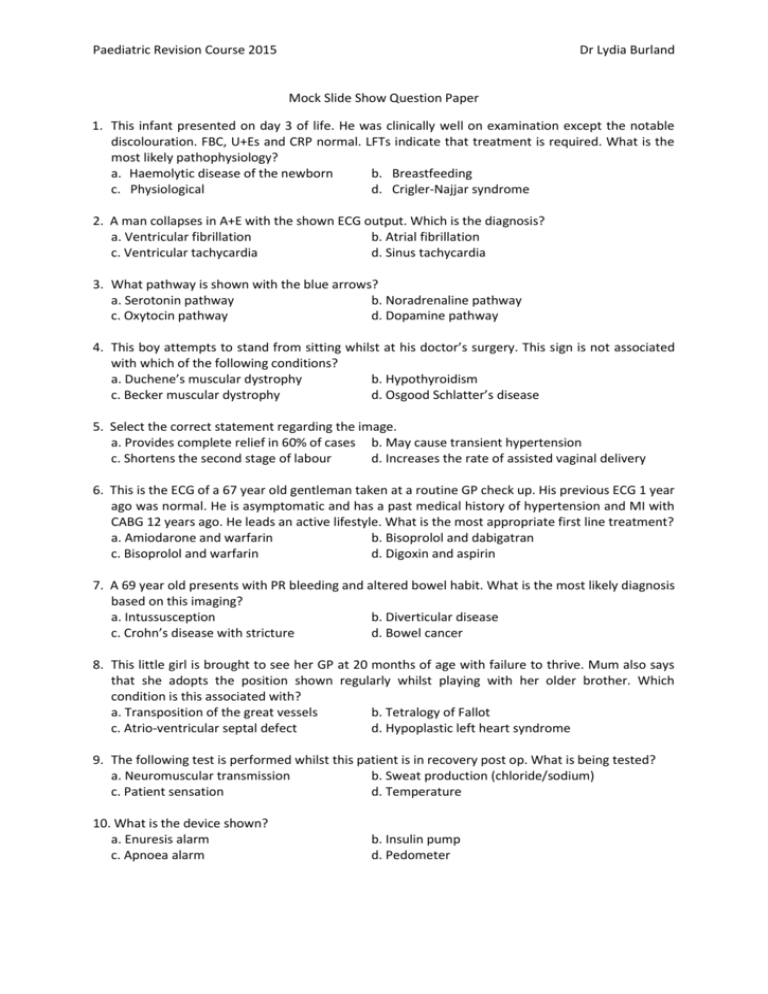
Paediatric Revision Course 2015 Dr Lydia Burland Mock Slide Show Question Paper 1. This infant presented on day 3 of life. He was clinically well on examination except the notable discolouration. FBC, U+Es and CRP normal. LFTs indicate that treatment is required. What is the most likely pathophysiology? a. Haemolytic disease of the newborn b. Breastfeeding c. Physiological d. Crigler-Najjar syndrome 2. A man collapses in A+E with the shown ECG output. Which is the diagnosis? a. Ventricular fibrillation b. Atrial fibrillation c. Ventricular tachycardia d. Sinus tachycardia 3. What pathway is shown with the blue arrows? a. Serotonin pathway b. Noradrenaline pathway c. Oxytocin pathway d. Dopamine pathway 4. This boy attempts to stand from sitting whilst at his doctor’s surgery. This sign is not associated with which of the following conditions? a. Duchene’s muscular dystrophy b. Hypothyroidism c. Becker muscular dystrophy d. Osgood Schlatter’s disease 5. Select the correct statement regarding the image. a. Provides complete relief in 60% of cases b. May cause transient hypertension c. Shortens the second stage of labour d. Increases the rate of assisted vaginal delivery 6. This is the ECG of a 67 year old gentleman taken at a routine GP check up. His previous ECG 1 year ago was normal. He is asymptomatic and has a past medical history of hypertension and MI with CABG 12 years ago. He leads an active lifestyle. What is the most appropriate first line treatment? a. Amiodarone and warfarin b. Bisoprolol and dabigatran c. Bisoprolol and warfarin d. Digoxin and aspirin 7. A 69 year old presents with PR bleeding and altered bowel habit. What is the most likely diagnosis based on this imaging? a. Intussusception b. Diverticular disease c. Crohn’s disease with stricture d. Bowel cancer 8. This little girl is brought to see her GP at 20 months of age with failure to thrive. Mum also says that she adopts the position shown regularly whilst playing with her older brother. Which condition is this associated with? a. Transposition of the great vessels b. Tetralogy of Fallot c. Atrio-ventricular septal defect d. Hypoplastic left heart syndrome 9. The following test is performed whilst this patient is in recovery post op. What is being tested? a. Neuromuscular transmission b. Sweat production (chloride/sodium) c. Patient sensation d. Temperature 10. What is the device shown? a. Enuresis alarm c. Apnoea alarm b. Insulin pump d. Pedometer Paediatric Revision Course 2015 11. Which hormone is represented by line A? a. Luteinising hormone c. Oestrogen Dr Lydia Burland b. Follicular stimulating hormone d. Progesterone 12. This 72 year old lady presents with slow, repetitive movements. Which of the following is not linked with this condition? a. Metoclopramide b. Levodopa c. Haloperidol d. Hyoscine-butyl bromide 13. Which of the following statements is true regarding these instruments? a. Less likely to cause maternal injury b. Commonly results in cephalohaematoma c. May cause facial nerve injury d. Increases C-section rates 14. A 2 year old presents with 3 hours of abdominal pain and recurrently draws his legs up whilst crying. Abdominal USS shows the following finding. What is the first line treatment? a. Laparotomy b. Air enema c. Barium swallow d. Drip and suck for 24-48 hours 15. A 54 year old woman undergoes a hysterectomy for heavy, painful periods. She is otherwise well. What is the most likely diagnosis based on the pathology sample? a. Uterine fibroids b. Ovarian cancer c. Endometriosis d. Sheehan’s syndrome 16. This child presents with a rash. She is otherwise well and does not seem to be affected by it. What is the causative organism? a. Pox virus b. Herpes simplex virus c. Coxsackie virus d. Toga virus 17. A 25 year old man is brought to A+E after being hit by a car. He is drowsy, with GCS 8/10 and has significant facial trauma. What is the diagnosis seen on CT head? a. Subarachnoid haemorrhage b. Extradural haemorrhage c. Subdural haemorrhage d. Haemorrhagic stroke 18. A 69 year old presents with chronic cough productive of white-grey sputum and decreased exercise tolerance over the last 3-4 months. Otherwise has a 50 pack year smoking history, hypertension and gout. What is the most likely diagnosis based the history and imaging? a. COPD b. Primary lung cancer c. Asthma d. Pleural effusion 19. A 19 year old male presented with acute confusion and SOB. These CXR appearances are not associated with which of the following diseases? a. Mesothelioma b. Testicular cancer c. Renal cell cancer d. Gynaecological cancers 20. A patient admitted to the acute medical ward has the blood levels shown on the graph. Which of the following should be performed? a. Further blood levels in 2 hours b. Commence naloxone infusion c. Commence N-acetylcysteine infusion d. Commence pabrinex infusion Paediatric Revision Course 2015 Dr Lydia Burland 21. Complications of this condition include which of the following? a. Precocious puberty b. Patent ductus arteriosus c. Increased risk of childhood leukaemia d. Sensorineural deafness 22. What action should be taken following this xray? a. Needle thoracocentesis b. Advance endotracheal tube c. Cardiac echo d. Pull back endotracheal tube 23. Which of the following is not an indication for the shown therapy according to NICE? a. Schizophrenia b. Severe depression c. Prolonged or severe mania d. Catatonia 24. Which of the following is not included in the DSM 5 diagnostic criteria? a. Restriction of dietary intake leading to low significantly low body weight b. Amenorrhea for ≥3 months c. Fear of weight gain or persistent behaviours to impede weight gain d. Disturbance in one’s view of their body weight or shape 25. Which of the following statements is true regarding the child seen? a. Life expectancy if born today is 30-40 years b. Increased risk of chronic myeloid leukaemia c. Increased risk of developing Alzheimer’s disease d. TFTs should be checked every 3 months 26. A 23 year old G2P1 presents with regular contractions. On assessment the cervix is fully dilated with clear liquor draining through the os, the fetal head remains high. CTG monitoring is commenced because of concerns during auscultation. What action should be taken? a. Commence oxytocinon drip and reassess in 2 hours b. Place the mother in the left lateral position and commence IV fluids c. Attempt fetal blood sampling +/- forceps delivery d. Emergency caesarean section 27. A 20 year old man presents with acute onset pain and swelling of his left testicle for the last 20 minutes. There is no other relevant medical or sexual history. What is the correct course of action? a. Urine dip and commence IV antibiotics b. Arrange urgent scrotal USS with dopplers c. Reassure and commence analgesia d. Urgent surgical exploration 28. Which of the following is not a common side effect of the medication shown? a. Weight gain b. Pancreatitis c. Erectile dysfunction d. Hallucinations 29. What is the most likely diagnosis? a. Rheumatoid arthritis b. Osteoarthritis c. Severe gout d. Systemic lupus erythematous Paediatric Revision Course 2015 Dr Lydia Burland 30. Screening of a 34 year old woman demonstrates low-grade dyskaryosis. What is the most appropriate next step in this patient’s management? a. Recall for repeat screening in 3 years b. Refer for colposcopy c. Recall for repeat screening in 3 months d. Send sample for HPV testing 31. A 21 year old student presents with the rash shown. He otherwise feels “flu-like” and has a temperature of 38.2oC. What is the most appropriate management? a. IV access, bloods including culture and meningococcal PCRs, IV fluids and IV ceftriaxone b. IV access, bloods including culture, lumbar puncture, IV fluids and IV ceftriaxone c. Urgent CT head to rule out raised ICP before lumbar puncture, then IV cetriaxone d. IV access, bloods including culture and meningococcal PCRs, IV fluids and IV benzylpenicillin 32. What does stage of the cycle does B represent? a. Re-audit b. Measure practice c. Analyse data d. Identify topic 33. This man presents with a persistent, intensely itchy rash. His past medical history includes a 12 month history of abdominal bloating, offensive diarrhoea and some weight loss. What is the next step in investigation/management? a. Food diary and allergy testing b. Serum immunoglobulins and IV aciclovir c. Skin biopsy and topical steroids d. Skin biopsy, serum IgA anti-tTG, gluten-free diet 34. An 18 year old woman presents with dysuria at ~35 weeks gestation. On examination she is noted to have to several perineal lesions. What would be most appropriate course of action? a. Swab and serology testing, referral to obstetricians and plan for elective caesarean section b. Urine MC+S, oral cephradine and topical oestrogen cream c. Admit for IV antibiotics and aciclovir, IV steroids (i.e. betamethasone) and induction of labour d. Swab lesions and advise mum vaginal delivery is safe with aciclovir prophylaxis 35. Which of the following are paired correctly? a. A = What is the year/season/date/day/month? B = Repeat after me “hippopotamus” b. A = What is the year/day/time? C = Can you repeat the address I told you? c. A = What is the year/season/date/day/month? C = Repeat the following “no ifs, ands, or buts” d. A = What is the year/day/time? D = CLOSE YOUR EYES 36. This man presents with a 3 week history of gradually increasing dyspnoea, chest pain and cough. What is the most appropriate initial management? a. Elevation of head and supplemental O2 b. Urgent chest radiotherapy c. Urgent angioplasty d. Anticoagulation 37. Regarding the shown device which of the following statements is true? a. No effect on spermatic penetration b. Failure rate 4-5% over 5 years c. Reduces menstrual blood loss d. Licensed for emergency contraception 38. This woman presents with SOB and wheeze. What is the most appropriate initial management? a. Oxygen, bronchodilators and 500mcg adrenaline 1:1000 b. Oxygen, bronchodilators and 500mcg adrenaline 10:1000 c. Oxygen, IV chlorphenamine and IV hydrocortisone d. Oxygen, salbutamol nebulisers and prednisolone
